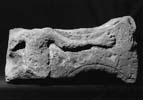Select a site alphabetically from the choices shown in the box below. Alternatively, browse sculptural examples using the Forward/Back buttons.
Chapters for this volume, along with copies of original in-text images, are available here.
Object type: Cross-head in two pieces [1]
Measurements:
a: H. 47 cm (18.5 in) W. 24 > 16 cm (9.5 > 6.3 in) D. 20 > 17 cm (7.9 > 6.7 in)
b: H. 23 cm (9 in) W. 23 cm (9 in) D. 17 cm (6.7 in)
Stone type: As Great Ayton 1 (All Saints), but the stone colour is light yellowish brown (10YR 6/4).
Plate numbers in printed volume: Ills. 303–8
Corpus volume reference: Vol 6 p. 119-120
(There may be more views or larger images available for this item. Click on the thumbnail image to view.)
A (broad) : The lateral arms of a cross-head survive in two pieces. The shape of the head, type B9, is outlined by an incised moulding. The background is plain and smoothly dressed, and there is a naked torso with exaggeratedly extended arms in high relief. The arms sag, and the hand is open with the fingers splayed. There are faint traces of a loincloth on the figure.
B (narrow) : A four-stranded closed circuit plait, the strands median incised.
C (broad) : A 'spine-and-boss' motif (cruciform head-pattern, type 3b: Bailey and Cramp 1988, fig. 7), with the central boss much worn.
D (narrow) : A four-stranded median-incised plait, which is more irregular and more damaged than on face B.
The carving of the figure is well modelled, and the cutting of the other faces is competent. Although there are no earlier 'loincloth' crucifixes in Yorkshire, this seems part of the Anglian tradition, looking back towards Rothbury 1, Northumberland (Cramp 1984, pl. 211, 1206), rather than showing the Hiberno-Norse influences seen at Kirklevington and elsewhere (Coatsworth 1979, I, 236). Since there is no indication that there were other figures attendant on Christ, Coatsworth has suggested that this demonstrates 'a development towards establishing the stone crucifix as a devotional object rather than a didactic one' (ibid., 235). The spine-and-boss motif is widely distributed in the northern sector of Yorkshire and in Cumbria (Chap. VI, p. 43).



